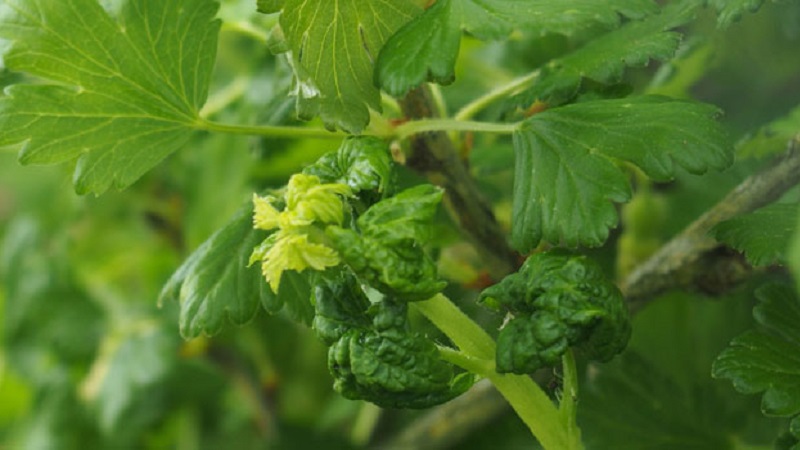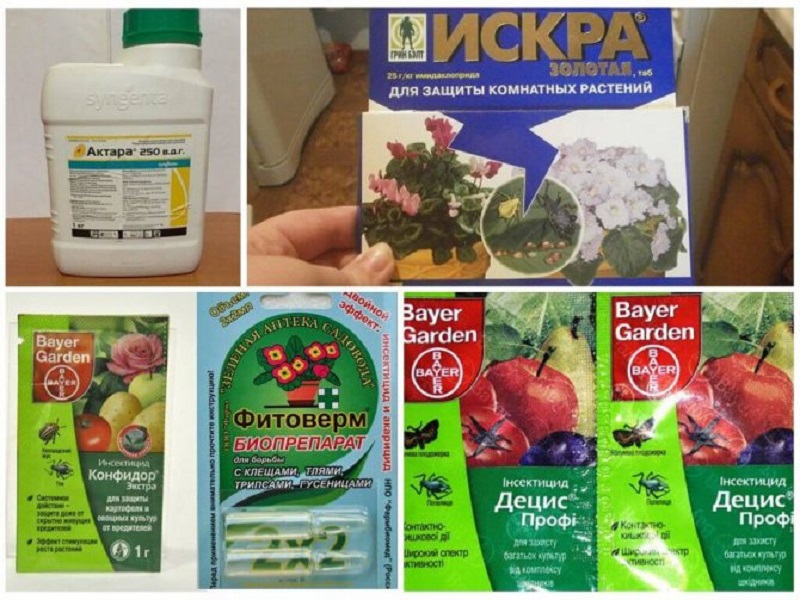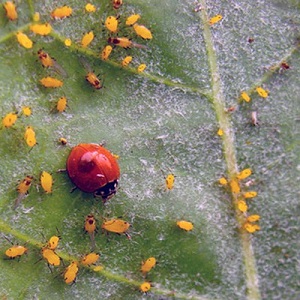What is dangerous for aphids on gooseberries and how to effectively deal with it
As soon as signs of aphid vital activity appeared on the gooseberry, you need to immediately start the fight. It belongs to a fertile insect, the larvae of which constantly suck the juices from the plant, actively reproduce, and become carriers of infections. Aphids easily move to neighboring crops, destroying a significant part of the crop. How to deal with an insect, learn from the article.
The content of the article
Signs of gooseberry aphid damage
After an attack of pests, gooseberries stop giving the usual amount of harvest, loses its visual appeal - the leaves curl, wither, turn yellow, dry up.
If you do not pay attention to these signs, the bush will die in the future. But not so much from the larvae as from the black sooty dew.

How to recognize a pest
Gooseberry or shoot aphids often settle on gooseberries.... The larvae are spindle-shaped, the body length is from 0.5 to 0.7 mm, the color is light green, the vitreous body. Individuals have large antennae and powerful jaws.
The presence of a colony on plants is recognized by the following signs:
- leaves begin to curl, deform, turn yellow and become a shelter for larvae;
- ants wield the shoots;
- the bush was covered with a sticky bloom with a gray tint.
At the end of the gooseberry flowering, winged female aphids begin to appear... They move to another part of the site or even to neighboring vegetable gardens, creating new colonies there. In the fall, eggs are laid again, from which new offspring will appear in the spring.
Harm done
Adults do not harm crops. Larvae inflict significant damage... They feed on the sap of plants and fruits. The gooseberry gradually withers, loses strength, often dies.
Pests become carriers of soot fungus... It in turn activates powdery mildew. First of all, the disease affects the lower part of the bush, then the upper shoots and fruits. The berries begin to deform, shrink and dry out. In gooseberries, photosynthesis is disrupted, and frost resistance decreases.
Aphids move to neighboring crops: currants, apple trees, cherries, zucchini, etc. If you do not stop its spread in time, the gardener will lose up to 60% of the total harvest by autumn.

The reasons
There are several obvious reasons.
Among them:
- Metabolic disease. Occurs from an excess or lack of trace elements (potassium and phosphorus) in the root system, the plant itself.
- Overgrown area. Unwillingness to remove weeds around plants in a timely manner leads to the appearance of various insects.
- A large number of anthills. Ants carry aphids, so they fight these two species of insects simultaneously.
- The rules of agricultural technology have been violated. This is the wrong choice landing sites, fallen leaves, non-compliance irrigation regime.
Ways to get rid of aphids on gooseberries
Aphids are destroyed by chemical, folk, mechanical means and agrotechnical methods... If neighboring crops are already affected by a pest, they are treated simultaneously with gooseberries.
Chemicals
Apply before the appearance of the first leaves or after harvest... It is impossible to carry out treatments during the fruiting period, since the berries will accumulate insecticidal components.It is not recommended to use pesticides during the flowering period: pollen becomes toxic, which leads to the death of a significant part of the bees.
Important! Work with drugs in protective clothing, mask and gloves. Be sure to read the manufacturer's advice. If it rains the next day after spraying, the procedure is repeated.
"Aktara"
It is a new generation insecticide with a broad spectrum of action.... Not dangerous for humans, animals, earthworms. It destroys aphids through the digestive system.
After treatment with Aktara, the protective properties are preserved for 15-30 days. A solution is prepared (2 g of the drug is diluted in 10 l of water), gooseberries are sprayed with it. The procedure is carried out in the evening in dry and calm weather. If the aphid has not receded, repeat the spraying after 7 days.
Fitoverm
It is a biological insecticide based on the waste products of soil microorganisms.... It belongs to broad-spectrum drugs and is not considered dangerous for other crops.
The solution is prepared before use: dilute 2 ml of the drug in 1 liter of water, mix thoroughly for a minute. The bushes are sprayed in the evening. If the mixture interacts with sunlight, its properties will be lost.
"Spark Double Effect"
it strong insecticide for aphid control and plant fertilization... It contains potassium and anti-stress supplements to help gooseberries recover from pests.
Dissolve 1 tablet in 1 liter of water, then filter the liquid and bring to a volume of 10 liters. The resulting product is sprayed with gooseberries. The procedure is performed in the evening in dry weather.

Traditional methods
This category is suitable for ardent opponents of pesticides and those who want to save money.
The main advantage of folk remedies is the ability to use throughout the growing season. gooseberry. They are absolutely safe for all living things and fruits, but an excess of working components causes burns on the leaves.
Most popular folk remedies against aphids:
- Garlic tincture. 200-300 g of crushed cloves are poured into 10 liters of water, infused for 3-4 hours, then filtered, poured into a spray bottle and sprayed with plants. The repeated procedure is carried out in 7-10 days.
- Lilac. Possesses deterrent properties. However, the process of preparing the tincture will take some time. Lilac flowers are harvested and dried for 1 week. Then 1 kg of raw material is poured into 6 liters of water and simmered in a water bath for 1 hour. The liquid is filtered, then placed in a dark place for a day. Add 20 g of grated laundry soap to the resulting infusion, mix thoroughly and spray the bushes. The procedure is repeated after 10-14 days.
- Onion peel. No less effective composition. 200 g is poured with a bucket of water and infused for 5 days, filtered and used for spraying. Reapply after 10 days.
Experienced gardeners recommend scattering wood ash under each gooseberry bush.... It will not only prevent the invasion of pests, but also saturate the root system with phosphorus, calcium and potassium when it enters the soil along with water.
Attention! Spraying with folk remedies is performed in the evening or early morning in dry weather. If you use the garlic tincture often, it will cause burns on the leaves. 3-4 treatments are enough for the entire growing season.
Agrotechnical techniques
The use of chemicals and folk remedies must be alternated with the following activities:
- Removal and destruction of infected green mass. Work is carried out with a clean tool.
- Timely pruning and thinning of shoots. The branches are carefully removed with pruning shears.
- Loosening and weeding. After each watering, the soil is turned over to a depth of 2-3 cm. The weeds are pulled out together with the roots.
- Top dressing with phosphorus-potassium fertilizers. To do this, 10 g of superphosphate is mixed with 5 g of potassium salt and diluted in 10 l of water. Insist for 2 days, then pour 1 liter under the bush.
- Mulching the soil. A fresh layer of mulch will not only block the path of the larvae, but also prevent the growth of weeds. They create a flooring from sawdust, tree bark, ash, peat.
Mechanical methods
There are several mechanical methods, but the result does not always meet expectations.:
- Aphids are washed off with a strong stream of water from a hose in 2-3 approaches. Get rid of ants in advance.
 Another way is duct tape. It is more time consuming but efficient. A piece of scotch tape is wound around the hand and the pests are collected. This method only works if the aphids have not multiplied to colony size.
Another way is duct tape. It is more time consuming but efficient. A piece of scotch tape is wound around the hand and the pests are collected. This method only works if the aphids have not multiplied to colony size.- Planting green manure. Marigolds, feverfew, lavender, marigolds, garlic, mustard, fennel, chives are good at repelling aphids.
- Launch enemies. Ladybugs, hoverfly larvae, lacewings, gall midges, parasites, earwigs, predatory beetles (for example, Atheta coriaria) scare off aphids well.
Earwigs are considered another dangerous pest of vegetable crops. Therefore, they will be present at the site anyway.
Features of pest control in different periods
During flowering and fruiting, they are used folk remedies, agrotechnical and mechanical methods.
The chemicals are used only before flowering or after harvest.
Gooseberry varieties especially resistant to aphids
They don't exist. Any gooseberry variety will be affected by aphids if certain activities are not followed for care.
Preventive measures
Getting rid of an aphid colony is much more difficult than preventing its appearance and subsequent reproduction.
To do this, perform:
- Top dressing in the form of complex mixtures. This gives the gooseberry 100% protection against pest attacks. To do this, 10 g of superphosphate is mixed with 5 g of potassium salt and diluted in 10 l of water. Insist for 2 days, then pour 1 liter under the bush.
- Regular pruning... The bush will give less energy to the formation of unnecessary stems. He will have enough energy to resist the decay.
- Cleaning and burning of fallen leaves. After the shrubs are spud for high-quality ventilation of the soil.
- Elimination of anthills. Ants and aphids are eternal allies. Therefore, getting rid of them will be a guaranteed way to prevent pests on gooseberries.
- Digging the site. After the snow melts and the soil warms up, the site is dug onto a shovel bayonet. So the aphid larvae will be on the surface and die.
Good advice and mistakes to avoid
Frequent watering of gooseberries is not recommended... It belongs to drought-resistant plants, therefore it requires 2-3 watering for the whole season. Damp soil often causes disease and pests. It is good if the surface of the earth is covered with a layer of mulch, and green manures are planted around the bushes.
It is unacceptable to use chemicals during the flowering and fruiting period of the crop... It is better to replace chemistry with folk tinctures and decoctions. In this case, spraying should be carried out only in the evening in dry weather.
Conclusion
Aphids on gooseberries are a dangerous phenomenon that entails the reproduction of a sooty fungus. If measures are not taken in time, up to 60% of the crop will be lost, the plant will die. It is important to remember one rule: it is better to prevent the appearance of pests than to try to get rid of a huge colony of insects.